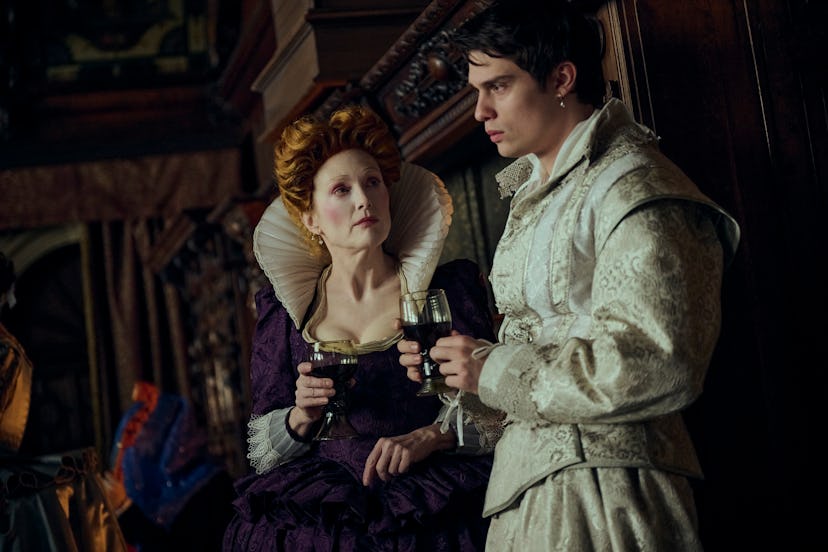Mary & George Will Fill The Great-Sized Gap in Your TV Schedule
The 17th-century set limited series balances historical record with modern wit.

If the past few months have proven anything, it’s that the zeal for royal drama (both fabricated and real) is stronger than ever. That makes now the perfect time for Starz to introduce its new limited series, Mary & George, for those of us who crave crowned spectacles, backroom scheming, and ruffled collars with a passion. But it’s not just the modern royal obsessed who should check out this new show starring Julianne Moore and the currently ubiquitous Nicholas Galitzine. It’s also for those who have felt a vacuum in their cultural intake since Hulu’s premature cancellation of The Great last year. Because just like the Elle Fanning-starring show, Mary & George’s irreverent and modern retelling of very real, if not unbelievable history is served up with a side of sex, duplicity, and sharpness that will make you feel like you’ve returned to 18th-century court.
Before anyone gets pedantic, yes, Mary & George is set approximately 150 years before Russian empress Catherine the Great’s rule, during Britain’s Jacobean period—an era undervalued in the popular zeitgeist until now. Based on Benjamin Woolley’s 2017 nonfiction book, The King’s Assassin: The Fatal Affair of George Villiers and James I, it tells the story of a mother and son duo (Moore and Galitzine) and their machinations to infiltrate the court of King James I, using nothing but Mary’s vehement smarts and George’s dashing good looks. Mary & George is grounded in the true story of James’s rule, his well-documented interest in men, and his relationship with the real-life George, who would eventually become the Duke of Buckingham.
Curran and Galitzine in Mary & George
Moore is striking as Mary, a low-born woman freed from the confines of an abusive husband for the first time, playing men like chess pieces to further her family’s station. Like Fanning’s Catherine, George gains agency and influence while simultaneously discovering himself. When we first meet Galitzine’s raffish George, he’s naive and romantic, a second son more interested in running off with the family’s servant than playing a part in his mother’s ambitious schemes. But as he reluctantly scales the heights of James’s court, his confidence also rises, while his mother’s grip grows unsteady.
These contemporary retellings of history have gained popularity over the past decade or so. Dickinson, The Favourite, and, of course, The Great, come to mind as recent pop culture projects that have adopted real stories, clothing, settings, and characters from the past while adding a modern sensibility. Did Queen Anne really swear like that? Did Catherine the Great have vehemently feminist tendencies? Does it even matter? These shows and movies aren’t purporting to be history lessons (though often, learning is an added pleasure). Mary & George is similar in that it trades strict historical fact for entertainment; while the major details are based in truth, anachronistic characters and conversation make the tale fit for television. “The thing we said in the writers’ room is, ‘We’re always trying to respect the truth, but we’re not going to be a slave to it,’” show creator and head writer, DC Moore (no relation to Julianne), said. If you want the whole truth, pick up a history book.
Moore and Galitzine in Mary & George
The seven-episode series quickly draws us into life at the palace court, with the malleable and mercurial King James (Tony Curran) at the center. He indulges in his young cup-bearers and beloved hunts, more interested in a good time than national welfare. It is in this debaucherous environment that George enters—initially at the bottom of the pyramid—and quickly makes his way through the ranks to become one of James’s favorites, posing a great threat to his right-hand-man in both politics and the royal bed-chamber, the Earl of Somerset (Laurie Davidson). As this love triangle plays out in the foreground, the more politically-minded are at work in the background—on the balconies and in the alleyways—maneuvering ways to extract Somerset in favor of George, as the one who shares James’s bed also drives policy. It calls to mind season one of The Great, as Catherine found time to plot a coup between sex-fueled interactions with Nicholas Hoult’s insolent King Peter. It’s frivolity and fun, sex and excess paired with duplicity of the highest magnitude.
There’s an irreverence to Mary & George, though it doesn’t reach the same level as the often blasphemous The Great. Side storylines of alligators appearing at court or dogs being dropped from roofs in the name of science are replaced by more realistic conversations around inheritance laws and James’s divided union. Sex is still a main character, alongside Moore, Galitzine, and Curran, though it’s treated more delicately than the constant romping escapades of The Great. But that’s not to say that Mary & George isn’t just as fun to watch. The costumes, settings, sharp dialogue, and unexpected twists keep the show moving forward at a steady pace, leaving us eager to see what happens next, even though it’s technically already written in history. DC Moore strikes the perfect balance between frivolity and earnestness, historical record and dramatized retelling, overwrought sex and somber reality, and to that, I say Huzzah!